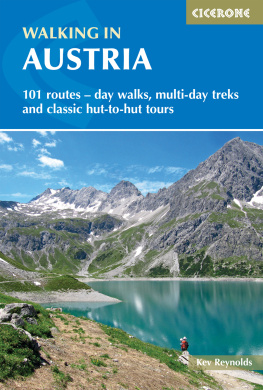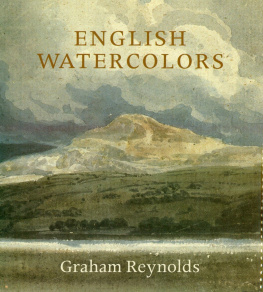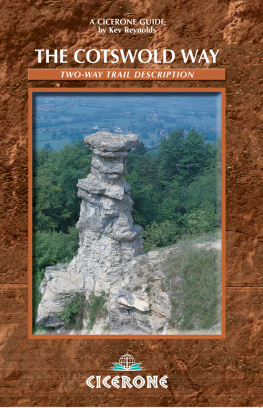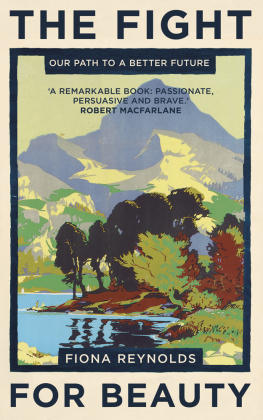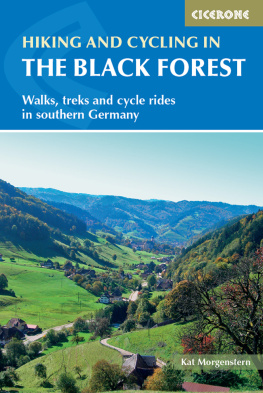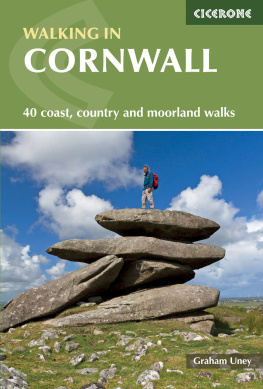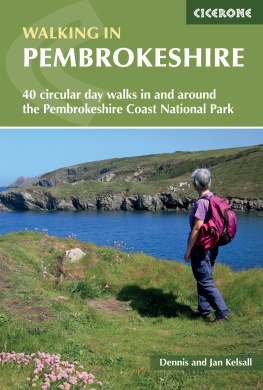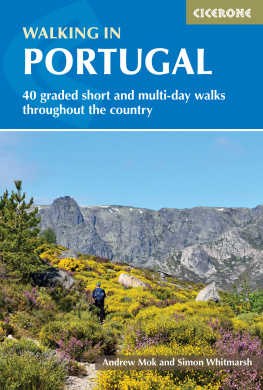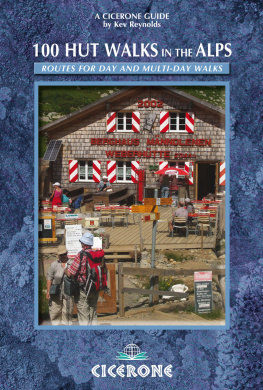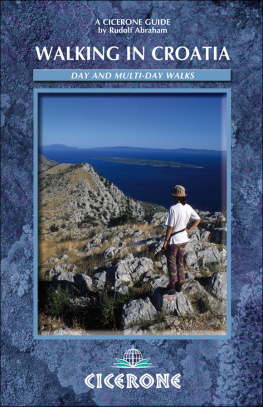About the Author
Kev Reynolds first led mountain holidays in Austria in 1967, since when he has returned to walk, trek and climb there on numerous occasions. A freelance author and photojournalist, he has written and illustrated brochures on walking in Austria for the Austrian National Tourist Office, produced publicity material for local tourist authorities there, and organised walking holidays for travel companies in several Austrian provinces.
A member of the Alpine Club, Austrian Alpine Club, and the Outdoor Writers and Photographers Guild, Kev was the first honorary member of the British Association of International Mountain Leaders (BAIML). He is author of more than 40 books, including guides to the Alps, Pyrenees and Himalaya, and several on walking in southern England.
In 2013 Cicerone published a collection of short stories and anecdotes gathered from Kevs 50-year mountain career, with the title A Walk in the Clouds . When not trekking or climbing in one of the worlds great ranges, he lives among what he calls the Kentish Alps and during the winter months travels throughout Britain to share his enthusiasm for the high places in a variety of lectures. Check him out on www.kevreynolds.co.uk.
Other Cicerone guides by the author
100 Hut Walks in the Alps
Alpine Pass Route
Chamonix to Zermatt
crins National Park
The Swiss Alps
Tour of Mont Blanc
Tour of the Jungfrau Region
Tour of the Oisans: The GR54
Tour of the Vanoise
Trekking in the Alps
Trekking in the Silvretta and Rtikon Alps
Walking in the Alps
Walking in the Bernese Oberland
Walking in the Valais
Walks in the Engadine
WALKING IN AUSTRIA
by Kev Reynolds
2 POLICE SQUARE, MILNTHORPE, CUMBRIA LA7 7PY
www.cicerone.co.uk
Kev Reynolds 2016
Second edition 2016
ISBN: 978 1 85284 859 0
First edition 2009
Printed in China on behalf of Latitude Press Ltd.
A catalogue record for this book is available from the British Library.
All photographs are by the author.
For mountain lovers everywhere.
Acknowledgements
In four decades of enjoyment of the Austrian Alps I have benefited from the kindness, generosity and hospitality of countless people. In particular I have Marian Telsnig (onetime Press Officer at the ANTO) to thank for giving me many opportunities to explore her mountains and introduce them to others. The late Cecil Davies, author of the first Cicerone guide to Austria, was always generous with information and advice, whilst officials at the YHA, Inghams and Thomson Holidays enabled me at various times to earn money in Austria by doing what I love most. It was a pleasure and a privilege to lead literally scores of walkers on routes in these mountains, and I gained much from them all. To Alan Henson, Dave Horley, Grazyna Tlaczala and Lise Winther, my thanks for update information. As ever, Im in awe of the Cicerone team in Milnthorpe who have managed to create this guidebook from my skeleton manuscript with their skills and talents my thanks too for their continued friendship, which counts for much. And lastly, for all the days and trails, huts, camps and cols weve shared in mountains around the world, my love and gratitude for my wife makes this her book as much as it is mine.
Updates to this Guide
While every effort is made by our authors to ensure the accuracy of guidebooks as they go to print, changes can occur during the lifetime of an edition. Any updates that we know of for this guide will be on the Cicerone website (www.cicerone.co.uk/859/updates), so please check before planning your trip. We also advise that you check information about such things as transport, accommodation and shops locally. Even rights of way can be altered over time. We are always grateful for information about any discrepancies between a guidebook and the facts on the ground, sent by email to updates@cicerone.co.uk or by post to Cicerone, 2 Police Square, Milnthorpe LA7 7PY, United Kingdom.
Front cover: From the shores of the Lnersee, walkers gain a distant view of the Schesaplana, left (Rtikon Alps, Route 2)
CONTENTS


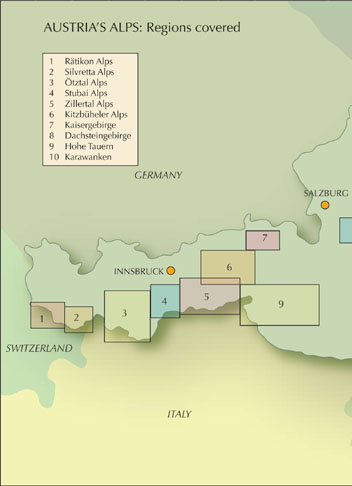
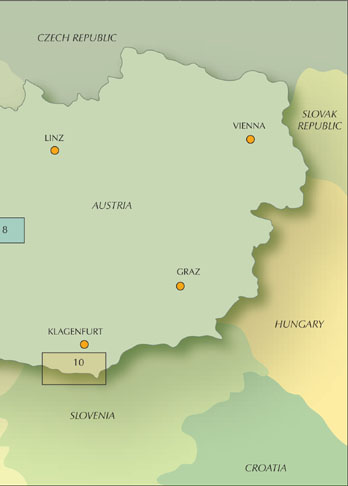
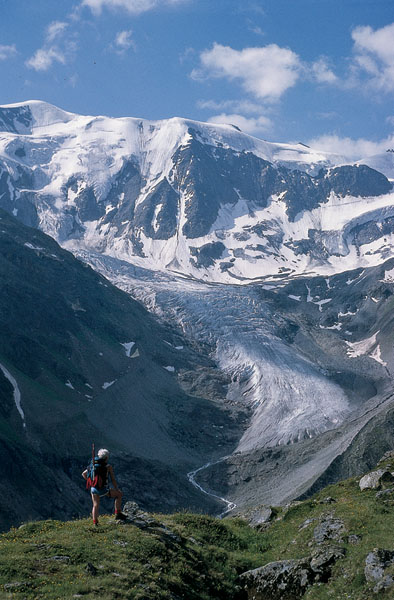
From the Fuldaer Hhenweg walkers gain a direct view of the Taschachferner (tztal Alps, Route 15)
INTRODUCTION
At four oclock on a June morning in 1967 I gazed breathless with wonder as the sun rose out of a distant valley, and flooded its glow across a sea of mountains whose snowfields and glaciers turned pink with the new day. My companions and I had spent the night with neither tent nor sleeping bag for comfort on a summit modest in altitude but generous in outlook, and greeted the dawn with smiles of delight. Then we descended as fast as we could. As we did we won a second sunrise, then another, and another, racing for pre-dawn shadows while the sun hastened to spread its goodness over all the Eastern Alps.
I was young then, leading walking groups in Austrias mountains, and loving every moment, every trail, every summit, valley, lake and meadow starred with flowers. Loving the pure alpine air, the cleanliness of the villages, the punctuality of bus and train, the certainty of a waymarked path, the smiles of each hut warden amused by my poor attempts to speak German. Loving life.
Forty years on I no longer race to beat the sunrise. Instead, I linger, sprawl on an alm pasture and dream. A klettersteig can still set my pulse racing, and trails continue to seduce me into wonderland, but now I take my time to get there. Ill sit for ages and listen to the birds, a stream, or the brush-strokes of the wind against a rock. But the sight of chamois or marmot thrills me even more than it did four decades ago, while a pass is as good as a summit, a mattress in a hut as welcome as any hotel bed, a night under a blanket of stars as enriching as ever.
Austrias Alps still draw me back, and repay every visit a thousandfold.
Austrias Alps
With more than 40,000km of well-maintained, waymarked footpaths; with countless attractive villages, hospitable hotels, inns and restaurants, pristine campsites, the worlds finest chain of mountain huts, an integrated public transport system, and breathtaking scenic variety, Austria must surely count as one of Europes most walker-friendly countries.
Its a country of great diversity, whose mountains range from gentle grass-covered hills of around 2000m, to rugged limestone spires and turrets erupting from a fan of scree, or snow-draped, glacier-clad peaks whose reflections are cast in crystal-clear lakes. In their valleys some of the continents loveliest villages are hung about with flowers in summer. On mid-height hillsides centuries-old timber haybarns and stone-built chalets squat among the pastures; these are the alms which add an historic dimension to the landscape. Elsewhere, heavy-eaved farmhouses double as restaurants; some provide accommodation in a rustic setting, and complement the hundreds of mountain huts built in remote locations, virtually every one of which exploits a viewpoint of bewitching beauty.

